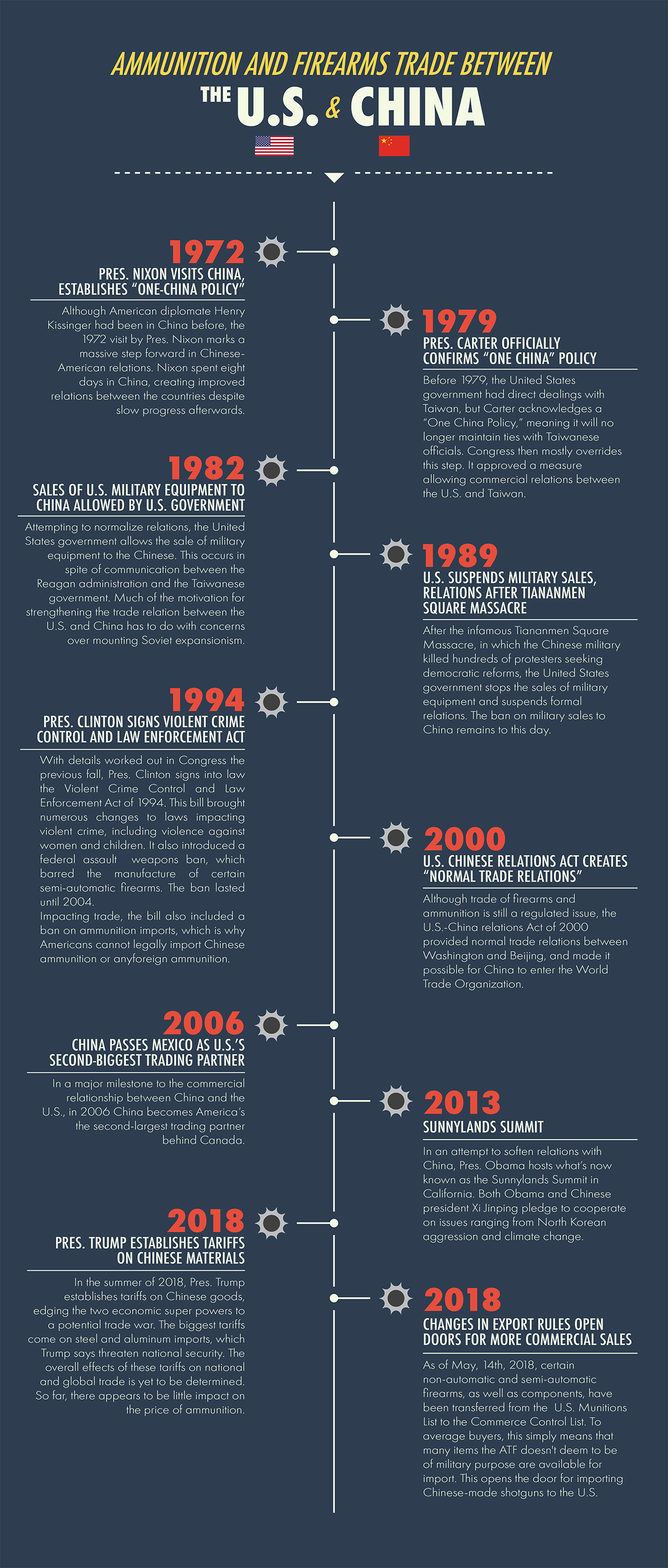With cheap electronics and seemingly constant talk about a trade imbalance between the U.S. and China — why can’t we find cheap Chinese guns and ammo on the shelves here in the United States?
American-Chinese relations have always gone back-and-forth to some extent. One decade we don’t even contact each other, the next we are working out detailed trade agreements. One year we’re talking with Taiwan, the next we’re giving lip service to the “One China” policy.
This competitive alliance is fraught with tension. It has had an impact on the availability of firearms and ammunition from China. As you might have noticed, you can’t purchase new Chinese rifles and pistols. However, you can purchase some Chinese-made shotguns and accessories. Gear like Chinese ammo cans are readily available to American shooters. It’s all due to a complex and ever evolving trade relationship. While attempting to benefit both countries the relationship remains a constant game of tug-of-war.
Why Can’t I Buy Cheap Chinese Made Ammunition?
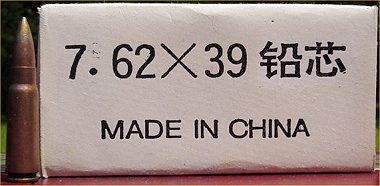
China is one of our biggest trading partners. Despite current tensions between the two countries’ leadership, you can find Chinese-manufactured goods in practically every store. So why not ammunition?
It all goes back to the Violent Crime Control and Law Enforcement Act of 1994. That legislation was most notable for the assault weapons ban that lasted until 2004.
That “Assault Weapons Ban” had other impacts as well. It included the fact that you cannot legally import most ammunition to the United States.
“Sporting Purposes” Largely Determines Firearm Import
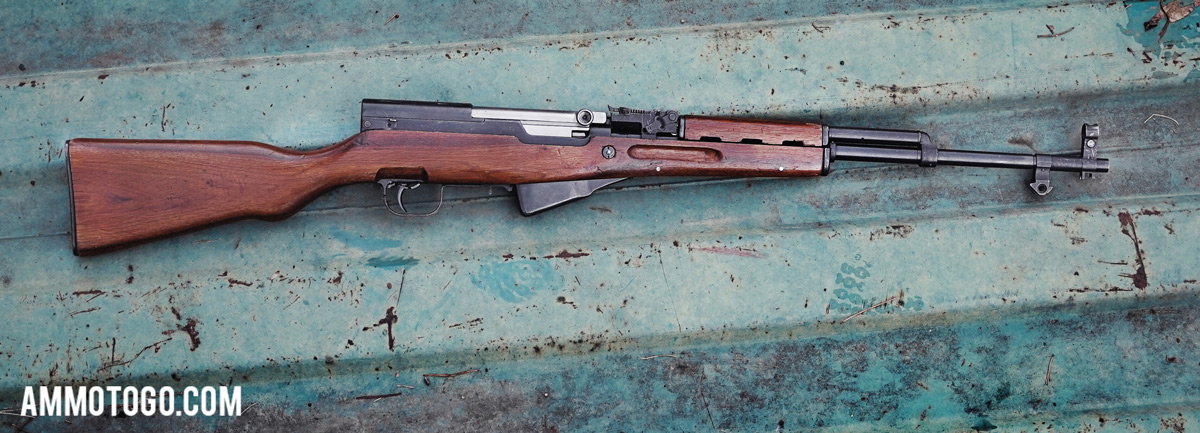
When it comes to importing firearms, from China or anywhere else, one of the most important concepts is the “sporting purpose” test.
Essentially, firearms that are classified as having a sporting purpose have much more lenient importation laws than other firearms. That means you are more likely to find hunting firearms, especially shotguns, available from foreign companies, including Chinese companies.
The Bureau of Alcohol, Tobacco, Firearms, and Explosives is one of the main organizations involved in the enforcement of firearms importation rules.
According to the ATF’s policies and procedures, it is “unlawful for any person other than an FFL (Federal Firearms License, aka a dealer), knowingly to import, or bring into the United States, any firearms or ammunition.” However, there is a clause that allows the importation of sporting ammunition and certain military surplus firearms that are considered collectibles or relics.
The one important factor at issue here is the Sporting and Firearms Ammunition section. It states the import must generally be recognized as suitable for a sporting purpose in order to be imported into the U.S.
This, of course, means that almost all shotguns are available for importation, because they are generally used for hunting, trap shooting, and similar purposes. Of course, those of us who hunt with an AR-15 rifle or shoot 3-gun might take issue with the government’s definition of “sporting purpose.”
What About AR-Style Rifles?
The “sporting purpose” clause, as we’ll call it, brings up an obvious issue. Clearly a pump action 12-gauge shotgun with a 26-inch barrel will be used for sporting purposes. But what about an AR-style rifle, such as an AR-15?
Previously these weapons, which are based on military firearms, were not considered to be a sporting tool. But since the assault -rifle ban was lifted in 2004, many of us use these rifles for clear sporting purposes, like hunting.
Industry leaders and government officials have noticed. These weapons automatically being classified as non-sporting is now in question. In fact, to break the stigma, these weapons are increasingly called “modern sporting rifles.” This has a much softer (and we’d argue more accurate) connotation than “assault rifle.”
ATF 1998 Study on Semi-auto Rifles
This debate actually goes back decades. Long before the ban was lifted, the ATF actually conducted a study on the suitability of semiautomatic rifles for sporting purposes. The ATF published the study in 1998. They found this type of rifle was “not generally recognized as particularly suitable for or readily adaptable to sporting purposes.”
Essentially, the study determined that because AR-style rifles were not suitable for importation simply because they have “general characteristics” that are similar to assault rifles used in the military. These are characteristics that “were designed for killing and disabling the enemy and distinguish the rifles from traditional sporting rifles.” Features such as a collapsible stock, separate pistol grips, and detachable magazines made them, according to the ATF, too dangerous for importation.
In the end, this study did nothing to change the importation status of AR-style rifles. But, it does demonstrate that people in positions of power were aware of the firearms’ use in hunting and other sports.
Since the sporting-purpose method or classifying firearms was implemented in 1968 as part of the Gun Control Act of 1968, a lot has changed in how people purchase and use these firearms.
In 1968, these weapons had virtually no use among the sporting and outdoors public. It seems that has clearly changed. There is a chance that, because their use has changed, their classification on imports will change.
If AR-style weapons are reclassified as having a sporting purpose, it would open the American market for foreign-made weapons. This seems it would, almost inevitably be budget-level, lower-quality products. But as you can guess, Americans would, just as inevitably, purchase them. This would squeeze the profits for American companies that enjoy a closed market.
Point of Interest: Some Chinese Manufacturers Completely Banned from U.S. Sales
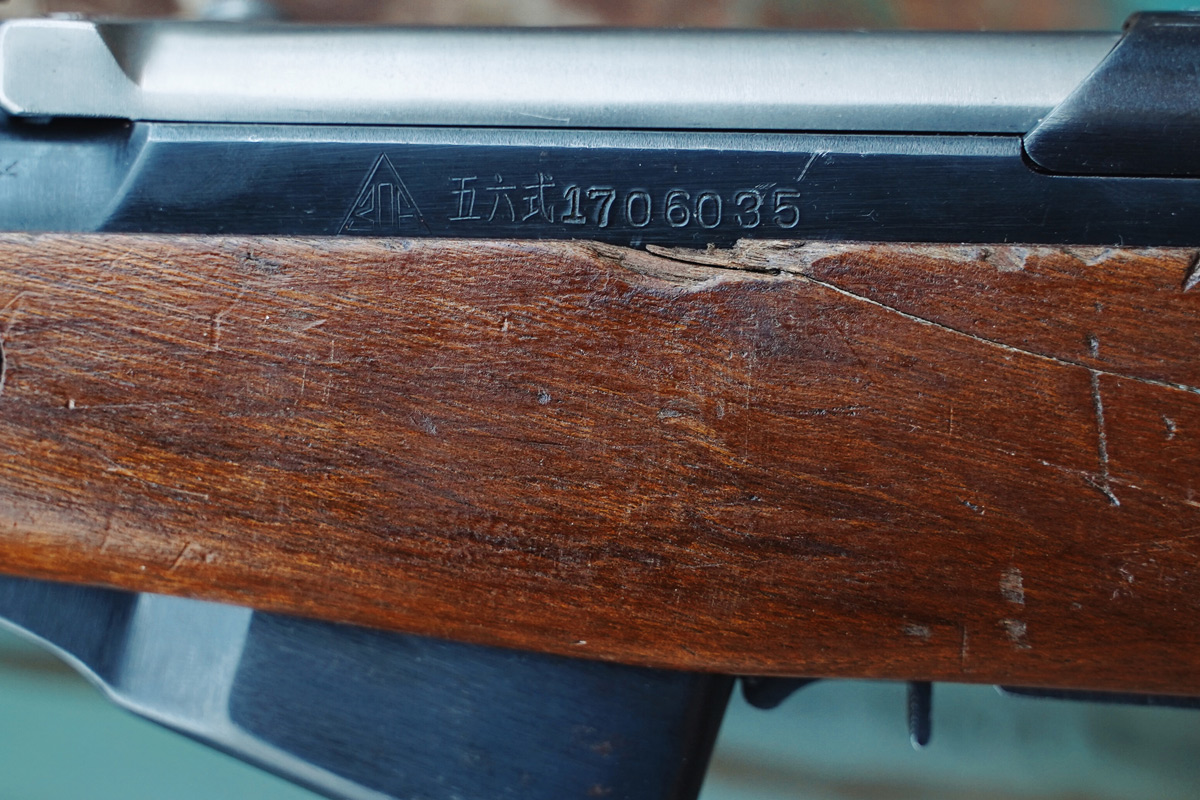
Today, you can find some Chinese products in the market, like hunting shotguns. But some Chinese companies are actually completely banned from selling products in the U.S., regardless of what product they are selling.
Most famously, the United States banned Norinco from sales because the weapons firm. The U.S. accused the firm of trying to sell illegal firearms here.
This impacts American buyers, as we are unable to purchase these firearms regardless of International and domestic trade laws. According to a story from The National Interest, AR-style rifles from Norinco, which are basically cheaper clones of American versions, are extremely popular in Canada. Yet, we can’t get our hands on them here.
From the National Interest:
Norinco clones firearms from all over the world. They’ve produced copies of pretty much every major design in the last half decade, from the east and west, from the CZ-75 to the MP5. Due to China’s prominent position in the World Trade Organization—and the fact that Norinco is a state-run corporation—countries are reluctant to bring up copyright infringement by the company.
Tariffs Appear to Have Had No Noticeable IMPACT on Ammunition Prices
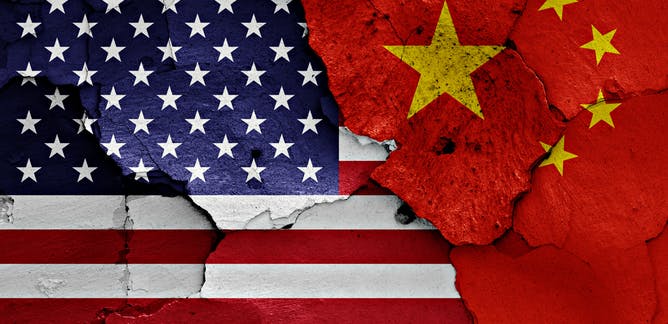
The American public recently received an education on the concept of tariffs. President Trump implemented tariffs on Chinese materials like aluminum and steel. This is part of an effort to realign what Trump claims are unfair trade agreements with China.
Tariffs are basically a tax on an imported product or material that is, in theory, paid by the importer. Many argue these “taxes” are often simply paid for by purchasers and then consumers through price increases. According to an article from USA Today, “the direct impact on consumer goods appears to be limited for now,” but a Business Insider article states that major American companies, including Wal-Mart, PepsiCo, Whirlpool, and General Motors have claimed that tariffs on Chinese goods will cause them to raise prices.
Despite the potential price increases for other products such as vehicles, soda cans, and washing machines, there appears to be little impact on the price of ammunition. Most of the ammo used by U.S. civilians is mostly made of brass. Brass, the metal used to make most ammo cases, is made from copper and zinc. So, it’s not using materials significantly impacted by the tariffs. (Some brass uses aluminum to make it stronger, but it’s not used at an amount high enough to create noticeable changes in ammo prices.)
Can Americans Export Firearms to China?
So far we’ve mostly discussed Chinese exporting firearms and ammunition into the United States. But what about our manufacturers and distributors exporting munitions into China? Can this be done?
The short answer is no.
Ever since the creation of the People’s Republic of China, firearms have been highly regulated, and there are numerous laws that restrict people’s ability to own and possess firearms, although there are specifications for civilian use that involve hunting and sporting purposes. According to a New York Times article, Chinese citizens can’t store a weapon in their home; they must store firearms at a gun range or authorized location. There are even laws that prohibit selling guns in China that are meant for export. In other words, some weapons can be made in China but not actually used in China.
These Chinese government heavily regulates bringing guns into the country. So, it is virtually impossible for an American company to export firearms into China.
One of the most important laws in China related to their firearms is the Firearms-Control Law, which took effect in 1996. This law regulates bringing guns into and out of China, and includes a provision that no one can bring guns into or out of the country unless a specific exception has been granted. Any firearms brought into the country must be registered at the border checkpoint.
Chinese-American Trade Relations Timeline
1968 – Gun Control Act
The Gun Control Act of 1968 created restrictions on interstate sales and firearms importations. This law created the standard of “sporting purposes” for imported firearms, which essentially states that firearms must be for hunting or organized target shooting. The law has lasting implications for American firearm and ammunition imports.
1969 – Chinese-Soviet Conflict Opens Door for U.S. Relations
Before 1969, the relationship between the United States and the People’s Republic of China was largely nonexistent. China largely dealt with the Soviet Union and isolated itself from western powers. However, differences in ideology and border skirmishes make the Soviet Union a threat to China. This created an opening for American diplomats.
1972 – Pres. Nixon Visits China, Establishes “One-China Policy”
Although American diplomate Henry Kissinger had been in China before, the 1972 visit by Pres. Nixon marks a massive step forward in Chinese-American relations. Nixon spent eight days in China, creating improved relations between the countries despite slow progress afterwards.
1979 – Pres. Carter Officially Confirms “One China” Policy
Before 1979, the United States government had direct dealings with Taiwan, but Carter acknowledges a “One China Policy,” meaning it will no longer maintain ties with Taiwanese officials. Congress then mostly overrides this step. It approved a measure allowing commercial relations between the U.S. and Taiwan.
1982 – Sales of U.S. Military Equipment to China Allowed by U.S. Government
Attempting to normalize relations, the United States government allows the sale of military equipment to the Chinese. This occurs in spite of communication between the Reagan administration and the Taiwanese government. Much of the motivation for strengthening the trade relation between the U.S. and China has to do with concerns over mounting Soviet expansionism.
1989 – U.S. Suspends Military Sales, Relations after Tiananmen Square Massacre
After the infamous Tiananmen Square Massacre, in which the Chinese military killed hundreds of protesters seeking democratic reforms, the United States government stops the sales of military equipment and suspends formal relations. The ban on military sales to China remains to this day.
1994 – Pres. Clinton Signs Violent Crime Control and Law Enforcement Act
With details worked out in Congress the previous fall, Pres. Clinton signs into law the Violent Crime Control and Law Enforcement Act of 1994. This bill brought numerous changes to laws impacting violent crime, including violence against women and children. It also introduced a federal assault weapons ban, which barred the manufacture of certain semi-automatic firearms. The ban lasted until 2004.
Impacting trade, the bill also included a ban on ammunition imports, which is why Americans cannot legally import Chinese ammunition or any foreign ammunition.
2000 – U.S. Chinese Relations Act Creates “Normal Trade Relations”
Although trade of firearms and ammunition is still a regulated issue, the U.S.-China relations Act of 2000 provided normal trade relations between Washington and Beijing, and made it possible for China to enter the World Trade Organization.
2006 – China Passes Mexico as U.S.’s Second-Biggest Trading Partner
In a major milestone to the commercial relationship between China and the U.S., in 2006 China becomes America’s the second-largest trading partner behind Canada.
2013 – Sunnylands Summit
In an attempt to soften relations with China, Pres. Obama hosts what’s now known as the Sunnylands Summit in California. Both Obama and Chinese president Xi Jinping pledge to cooperate on issues ranging from North Korean aggression and climate change.
2018 – Pres. Trump Establishes Tariffs on Chinese Materials
In the summer of 2018, Pres. Trump establishes tariffs on Chinese goods, edging the two economic super powers to a potential trade war. The biggest tariffs come on steel and aluminum imports, which Trump says threaten national security. The overall effects of these tariffs on national and global trade is yet to be determined. So far, there appears to be little impact on the price of ammunition.
2018 – Changes in Export Rules Open Doors for More Commercial Sales
As of May, 14th, 2018, certain non-automatic and semi-automatic firearms, as well as components, have been transferred from the U.S. Munitions List to the Commerce Control List. To average buyers, this simply means that many items the ATF doesn’t deem to be of military purpose are available for import. This opens the door for importing Chinese-made shotguns to the U.S.


